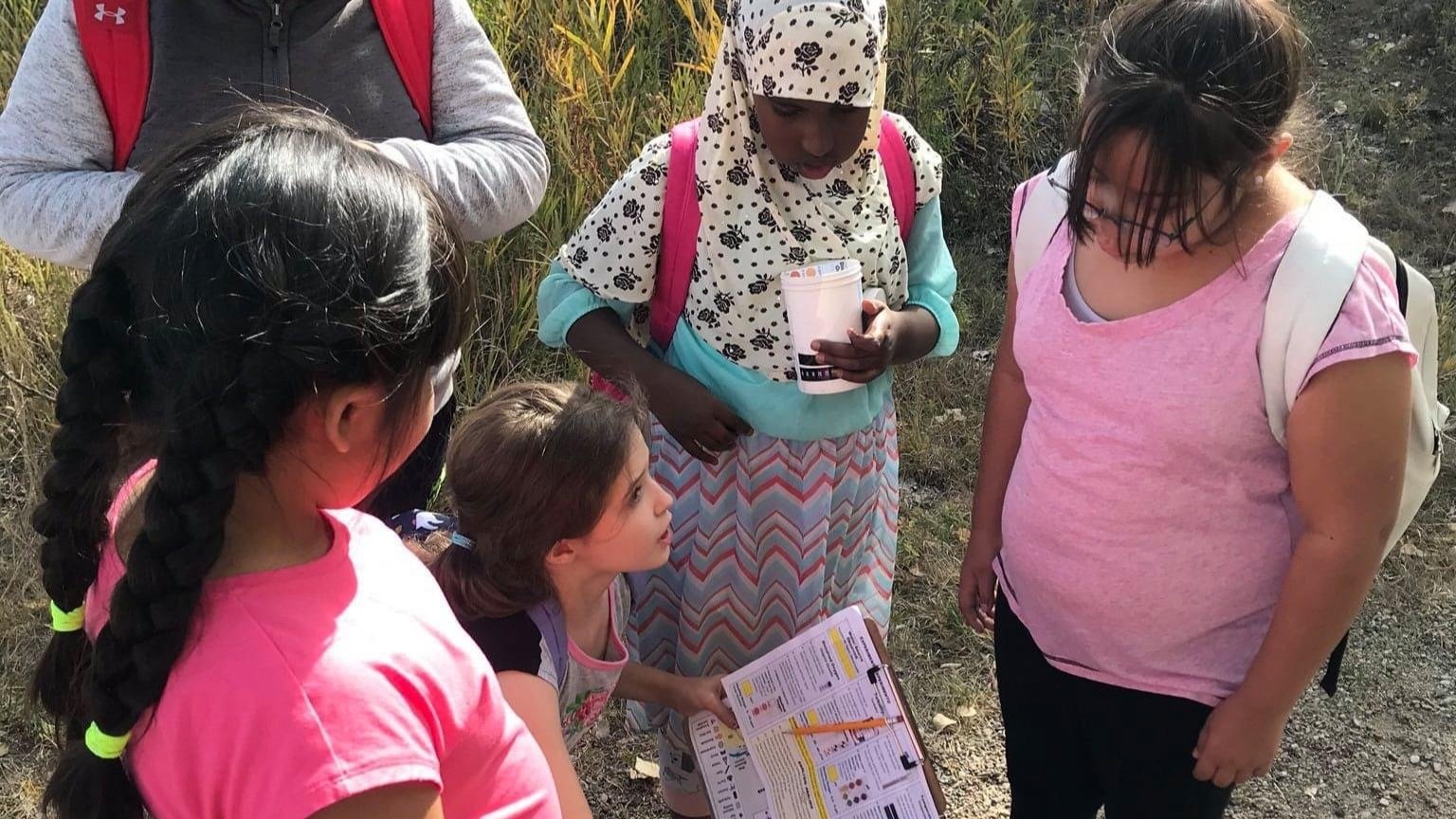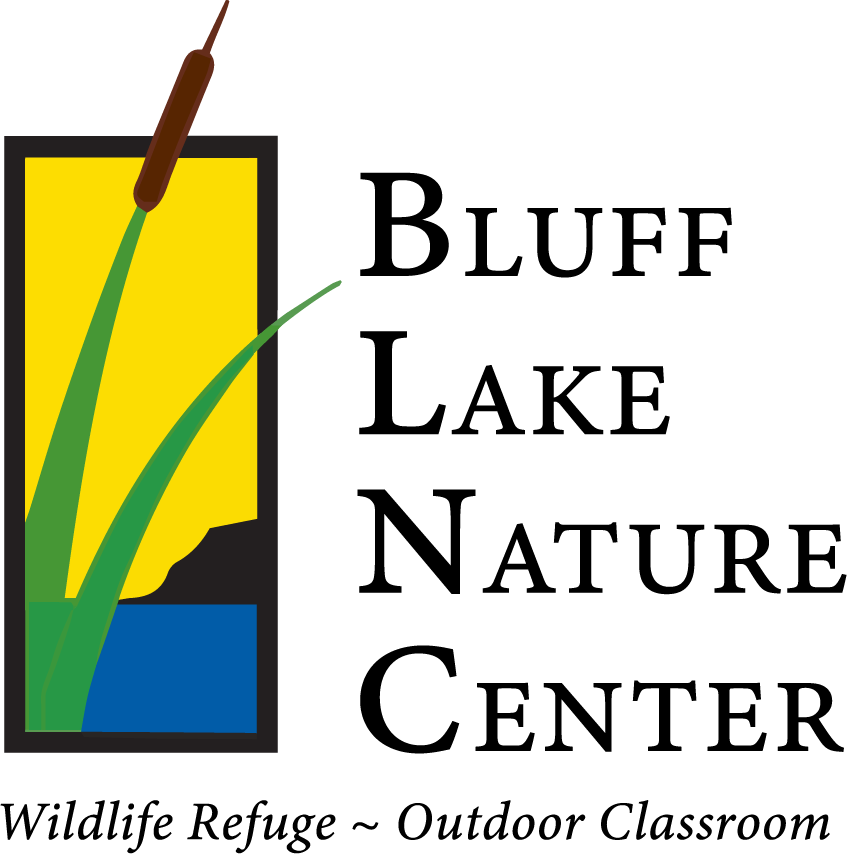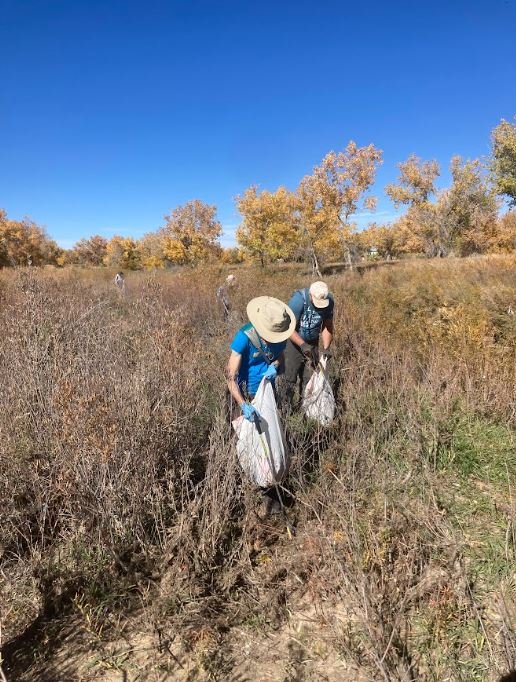
FIELD TRIPS
Do you want to enjoy a fun learning experience out in nature with your classroom, home-school group, club, or family? Then Bluff Lake Nature Center is the perfect spot for you!
Our field trips consist of a facilitated program, outdoor play time, and lunch time at the end of the program. We offer a variety of topics for ages ECE through 12th. Scroll down and choose a topic for your field trip!
Select programs have worksheets available in English and Spanish, and a Spanish-speaking educator is available upon request for any topic.
We encourage Title I Schools to visit us as fees are waived and bussing is reimbursed!
Please scroll all the way down to view our NEW stewarship field trips!
FIELD TRIP OPTIONS
Sensory Discovery (ECE-1st)
Students will use their senses to explore Bluff Lake as an animal does, through sight, sounds, smell, and touch! Expert environmental educators and interactive games will help the natural world come alive. Students will be introduced to some of the many animals, plants, and habitats of Bluff Lake.
CAS-SC GLE Code (NGSS): SC.K.2.1 (K-LS1-1); SC.K.3.2.
In-Person Field Trip Worksheet: None
Worksheets and Activities (free to use or modify): Sensory Scavenger Hunt
All About Animals (ECE-6th)
Students will learn about 9+ different animals, their characteristics, habitats and signs. Our environmental educators will lead students on a hike around Bluff Lake where we will look for signs of animals. This includes prairie dog holes and scats, beaver teeth markings on trees, animal prints on the ground, and much more. We will also talk about challenges each animal faces and human’s impact.
CAS-SC GLE Code (NGSS): SC.K.2.1 (K-LS1-1, K-ESS2-2, K-ESS3-1, K-ESS3-3); SC.2.2.2 (2-LS4-1); SC.3.2.4 (3-LS4-2); SC.3.2.5 (3-LS4-3).
In-Person Field Trip Worksheet: Animal Worksheet
Healthy Habitats (K-1st)*
Students will discover what makes a good habitat, the different habitats of Bluff Lake, and the many types of living things in each. Our environmental educators will guide students in making their own observations of the plants and animals in each habitat, and students will look for ways these species can find what they need to survive.
CAS-SC GLE Code (NGSS): SC.K.2.1 (K-LS1-1, K-ESS2-2, K-ESS3-1, K-ESS3-3); SC.1.2.1 (1-LS1-1); SC.1.2.2 (1-LS3-1); SC.2.2.2 (2-LS4-1).
In-Person Field Trip Worksheet: Habitat Comparison Worksheet
Worksheets and Activities (free to use or modify): Habitats Question Sheet (K-3)
Nature Cycles (1st-6th)*
Take a walk around Bluff Lake while learning about all different types of nature’s cycles. Some of the life cycles students may learn about are frogs, Monarch butterflies, cicadas and plants. Students will also have the opportunity to learn about the water cycle along with the prairie and wetland food webs. They will be given time to explore, make observations and ask plenty of questions.
CAS-SC GLE Code (NGSS): SC.K.2.1 (K-LS1-1, K-ESS2-2, K-ESS3-1); SC.2.2.2 (2-LS4-1); SC.3.2.1 (3-LS1-1); SC.5.1.4 (5-PS3-1), SC.5.2.2 (5-LS2-1).
In-Person Field Trip Worksheet: Wetland Food Web Activity
Worksheets and Activities (free to use or modify): Habitats & Food Webs Question Sheet (4-6)
Outdoor Survival (1st-6th)
In addition to enjoying a hike around the many beautiful areas of Bluff Lake, students will also learn and practice some skills they can use to enjoy nature more responsibly. We will provide field equipment such as maps, compasses, and binoculars for students to practice with, and will also discuss what to do if you are lost or encounter a wild animal. Students will also have the chance to practice building their own emergency shelter.
CAS-SC GLE Code (NGSS): SC.3.2.4 (3-LS4-2); SC.3.2.5 (3-LS4-3); SC.4.3.3 (4-ESS2-2); SC.5.1.1 (5-PS1-3); SC.MS.2.7 (MS-LS2-4); SC.MS.3.10 (MS-ESS3-3).
In-Person Field Trip Worksheet: Field equipment lending, no worksheet
Prairie Dog Mission (3rd-6th)*
Students will investigate the question, “Which of the prairie dog colonies at Bluff Lake has the healthiest population?” They will visit the colonies and take their own census, looking for clues such as sightings of adult and young prairie dogs, number and placement of holes, amount of scat, nearby food sources, other animals in the area, and human influences. After the exploration hike, students will draw their own conclusions and discuss the different ways that people and prairie dogs can coexist.
CAS-SC GLE Code (NGSS): SC.3.2.1 (3-LS1); SC.3.2.3 (3-LS3); SC.3.2.4 (3-LS4); SC.4.2.1 (4-LS1); SC.4.3.4 (4-ESS3); SC.4.3.3 (4-ESS2); SC.5.1.4 (5-PS3); SC.5.2.1 (5-LS1); SC.5.1.1 (5-PS1); SC.5.2.2 (5-LS2); SC.5.3.5 (5-ESS3); SC.MS.1.5 (MS-PS3); SC.MS.2.1 (MS-LS1); SC.MS.2.5 (MS-LS2); SC.MS.3.4 (MS-ESS2); SC.MS.3.8 (MS-ESS3).
In-Person Field Trip Worksheet: Prairie Dog Worksheet
Water Mission (2nd-6th)*
Students will investigate the question, “Which water source at Bluff Lake is the healthiest for aquatic animals?” They will look for signs of wildlife and human influence at Bluff Lake, Sand Creek, and our storm-water outfalls, then use a water monitoring kit to run their own tests of pH, dissolved oxygen, and turbidity. After the exploration hike, they will draw their own conclusions and discuss the different ways that people can protect the health of water systems.
CAS-SC GLE Code (NGSS): SC.3.2.1 (3-LS1); ; SC.3.2.3 (3-LS3); SC.3.2.4 (3-LS4); SC.4.2.1 (4-LS1); SC.4.3.4 (4-ESS3); SC.4.3.2 (4-ESS2); SC.5.1.4 (5-PS3); SC.5.2.1 (5-LS1); SC.5.1.1 (5-PS1); SC.5.2.2 (5-LS2); SC.5.3.5 (5-ESS3); SC.MS.1.5 (MS-PS3); SC.MS.2.1 (MS-LS1); SC.MS.2.5 (MS-LS2); SC.MS.3.4 (MS-ESS2); SC.MS.3.8 (MS-ESS3).
In-Person Field Trip Worksheet: Water Worksheet
Worksheets and Activities (free to use or modify): Water Question Sheet (1-3)
*Worksheets in English and Spanish.
Ecosystems Mission (2nd-6th)*
Students will investigate the question, “Which ecosystem at Bluff Lake has the most biodiversity (different species of plants and animals)?” They will use binoculars and magnifying glasses to examine different species in the prairie, wetland, and riparian habitats, then record their observations and use field guides to identify the species. After the exploration hike, they will draw their own conclusions and discuss the different ways that people can protect the biodiversity of natural ecosystems.
CAS-SC GLE Code (NGSS): SC.3.2.1 (3-LS1); SC.3.2.3 (3-LS3); SC.3.2.4 (3-LS4); SC.4.2.1 (4-LS1); SC.4.3.4 (4-ESS3); SC.4.3.2 (4-ESS2); 5-LS1 (5-PS3); SC.5.1.1 (5-PS1); SC.5.2.2 (5-LS2); SC.5.3.5 (5-ESS3); SC.MS.1.5 (MS-PS3); SC.MS.2.1 (MS-LS1); SC.MS.2.5 (MS-LS2); SC.MS.3.4 (MS-ESS2); SC.MS.3.8 (MS-ESS3).
In-Person Field Trip Worksheet: Ecosystem Worksheet
Problem Based Learning (K-12th)*
Bluff Lake's unique location as a wildlife refuge surrounded by urban development makes it a great place to study how humans and the natural world interact, either successfully or unsuccessfully. In this program students will record their observations about human/environment interactions, identify potential areas of improvement, choose a problem, and start the process of developing a solution (to be continued back at the classroom). Students gain ownership over the problem and a chance to take action on an environmental issue they care about.
Additional Details:
Field trips are from 9:30am-12pm Tuesday through Friday (may be shortened upon request for younger grades or colder weather)
Your class is welcome to remain on site afterward to eat lunch on top of the bluff
We will make a 30-minute visit to your classroom the Monday before the field trip to help the students prepare and share interesting animal “biofacts” (skulls, pelts, etc.)
$8 per student
We have a limit of 45 students per field trip. If your school has more than 45 students, we can do multiple field trip days.
Fees waived and transportation costs reimbursed for Title I schools
BLNC staff has determined, based on industry standards and our knowledge of the site, that it is not safe to proceed with field trips if the weather forecast calls for a high temperature of 40 degrees Fahrenheit or less.
Scheduling:
Submit an fieldtrip request form here if you would like to schedule a trip for the 2023-2024 school year. If your group is larger than 45 students, please be prepared to come over two separate dates.
If you have any questions, please check out our FAQ page or contact education@blufflake.org with questions.
STEWARDSHIP FIELD TRIP OPTIONS
LNT + Trash Pickup (6th-12th)
All year round
Students will learn about Leave No Trace (LNT) principles, trash decomposition, and Bluff Lake’s stormwater drain system. Students will finish the field trip with a trash pickup stewardship project led by our Natural Resource Director. We will provide trash pickers, gloves, trash bags, and a challenge! Weigh your trash bags and see if you can collect the most trash!
NGSS: MS-ESS3-4, MS-ESS3-3, MS-LS2-5, HS-ESS3-4
Colorado State Standards: RWC.1.1
Healthy Habitats + Invasive Plant Removal (6th-12th)
Seasonal availability - summer
Students will learn about various habitats at Bluff Lake and what makes them healthy, what species are native vs. invasive, and what roles humans play in it all. Students will finish the field trip with an invasive plant removal stewardship project led by our Natural Resource Director. We will provide gloves and necessary tools.
NGSS: MS-LS2-4, MS-LS2-5, HS-ESS3-3, HS-LS2-7, HS-LS2-6
Beavers! Keystone Species + Beaver Deterrent (6th-12th)
Seasonal availability - fall and winter
Students will learn about beavers as a keystone species, tree health, and the dynamic relationship between humans and ecosystems. Students will finish the field trip with a beaver painting stewardship project led by our Natural Resource Director. This involves painting tree to deter beavers. We will provide paint, paintbrushes, and several smocks.
NGSS: MS-LS2-4, MS-LS2-2, MS-LS2-1, HS-ESS3-3, HS-LS2-7, HS-LS2-6
Additional Details:
Field trips are 2 hours long Tuesday through Friday (may be shortened upon request or for colder weather)
Your class is welcome to remain on site afterward to eat lunch on top of the bluff
$8 per student
We have a limit of 25 students per field trip. If your school has more than 25 students, we can do multiple field trip days.
Fees waived and transportation costs reimbursed for Title I schools
BLNC staff has determined, based on industry standards and our knowledge of the site, that it is not safe to proceed with field trips if the weather forecast calls for a high temperature of 40 degrees Fahrenheit or less.
Scheduling:
To schedule a Stewardship Field Trip, email our Natural Resource Director tess@blufflake.org












